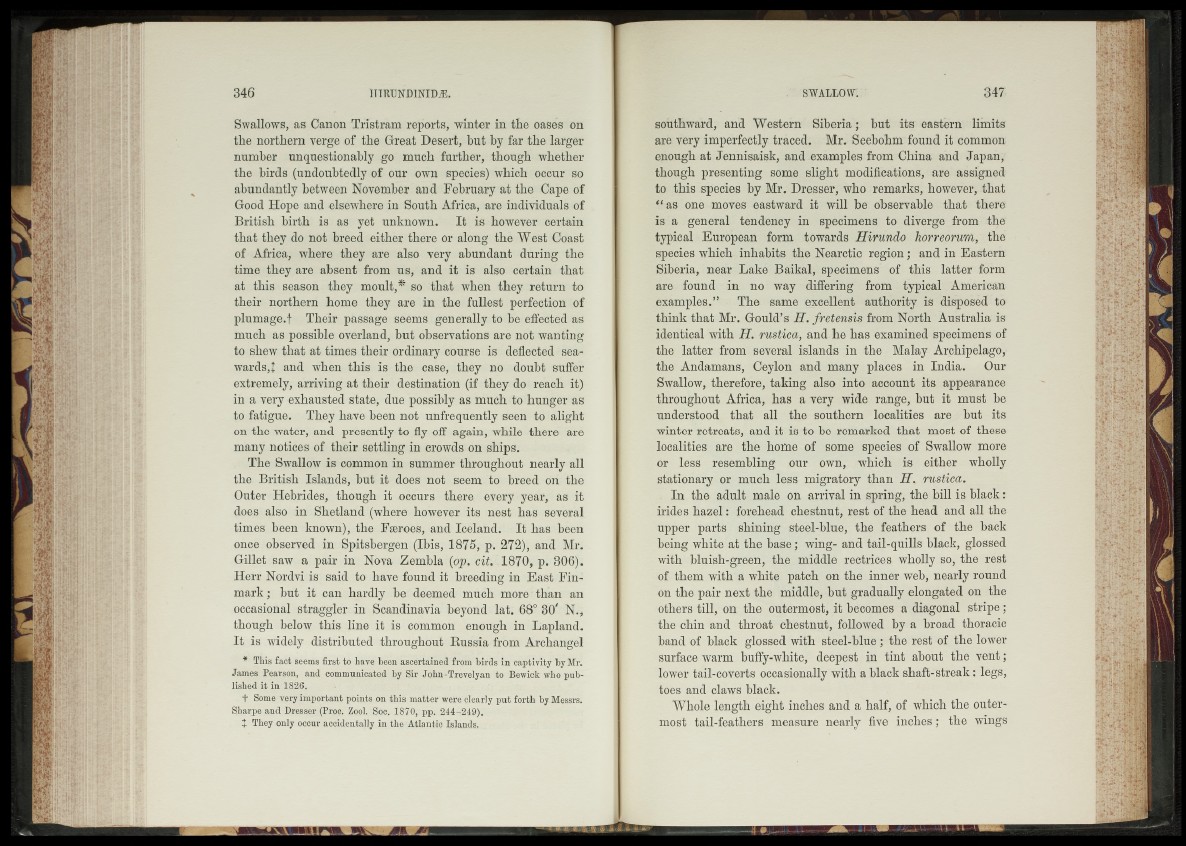
Swallows, as Canon Tristram reports, winter in the oases on
the northern verge of the Great Desert, but by far the larger
number unquestionably go much further, though whether
the birds (undoubtedly of our own species) which occur so
abundantly between November and February at the Cape of
Good Hope and elsewhere in South Africa, are individuals of
British birth is as yet unknown. It is however certain
that they do not breed either there or along the West Coast
of Africa, where they are also very abundant during the
time they are absent from us, and it is also certain that
at this season they moult,* so that when they return to
their northern home they are in the fullest perfection of
plumage.t Their passage seems generally to be effected as
much as possible overland, but observations are not wanting
to shew that at times their ordinary course is deflected seawards,!
and when this is the case, they no doubt suffer
extremely, arriving at their destination (if they do reach it)
in a very exhausted state, due possibly as much to hunger as
to fatigue. They have been not unfrequently seen to alight
on the water, and presently to fly off again, while there are
many notices of their settling in crowds on ships.
The Swallow is common in summer throughout nearly all
the British Islands, but it does not seem to breed on the
Outer Hebrides, though it occurs there every year, as it
does also in Shetland (where however its nest has several
times been known), the Faeroes, and Iceland. It has been
once observed in Spitsbergen (Ibis, 1875, p. 272), and Mr.
Gillet saw a pair in Nova Zembla (op. cit. 1870, p. 306).
Herr Nordvi is said to have found it breeding in East Fin-
mark ; but it can hardly be deemed much more than an
occasional straggler in Scandinavia beyond lat. 68° SO7 N.,
though below this line it is common enough in Lapland.
It is widely distributed throughout Russia from Archangel
* This fact seems first to have been ascertained from birds in captivity by Mr.
James Pearson, and commnnicated by Sir John-Trevelyan to Bewick who published
it in 1826,
t Some very important points on this matter were clearly put forth by Messrs.
Sharpe and Dresser (Proc. Zool. Soc. 1870, pp. 244-249).
+ They only occur accidentally in the Atlantic Islands,
southward, and Western Siberia; but its eastern limits
are very imperfectly traced. Mr. Seebohm found it common
enough at Jennisaisk, and examples from China and Japan,
though presenting some slight modifications, are assigned
to this species by Mr. Dresser, who remarks, however, that
“ as one moves eastward it will be observable that there
is a general tendency in specimens to diverge from the
typical European form towards Hirundo horreorum, the
species which inhabits the Nearctic region; and in Eastern
Siberia, near Lake Baikal, specimens of this latter form
are found in no way differing from typical American
examples.” The same excellent authority is disposed to
think that Mr. Gould’s H. fretensis from North Australia is
identical with H. rustica, and he has examined specimens of
the latter from several islands in the Malay Archipelago,
the Andamans, Ceylon and many places in India. Our
Swallow, therefore, taking also into account its appearance
throughout Africa, has a very wide range, but it must be
understood that all the southern localities are but its
winter retreats, and it is to be remarked that most of these
localities are the home of some species of Swallow more
or less resembling our own, which is either wholly
stationary or much less migratory than H. rustica.
In the adult male on arrival in spring, the bill is black:
irides hazel: forehead chestnut, rest of the head and all the
upper parts shining steel-blue, the feathers of the back
being white at the base; wing- and tail-quills black, glossed
with bluish-green, the middle rectrices wholly so, the rest
of them with a white patch on the inner web, nearly round
on the pair next the middle, but gradually elongated on the
others till, on the outermost, it becomes a diagonal stripe;
the chin and throat chestnut, followed by a broad thoracic
band of black glossed with steel-blue ; the rest of the lower
surface warm buffy-white, deepest in tint about the vent;
lower tail-coverts occasionally with a black shaft-streak; legs,
toes and claws black.
Whole length eight inches and a half, of which the outermost
tail-feathers measure nearly five inches; the wings